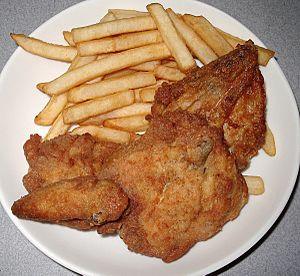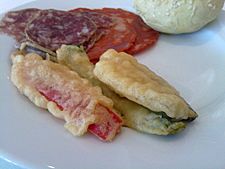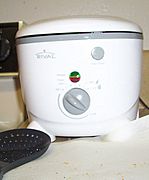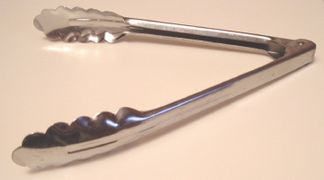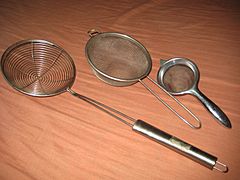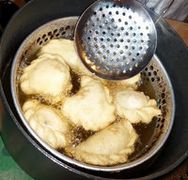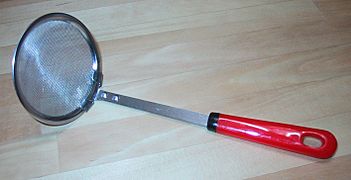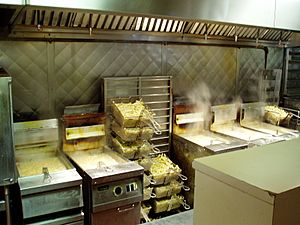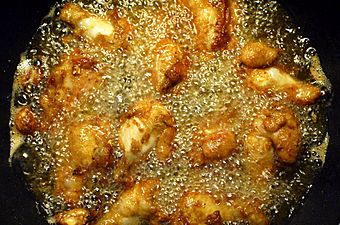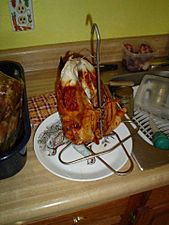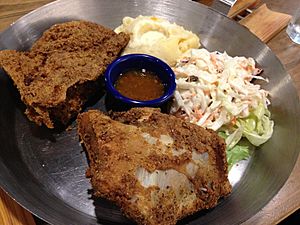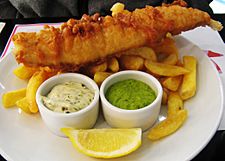Deep frying facts for kids
Deep frying is a way of cooking food. It involves putting food into very hot oil or fat. This method cooks food super fast!
Contents
How Deep Frying Works
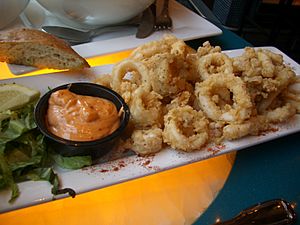
When done correctly, deep frying doesn't make food too oily. This is because the water inside the food pushes the oil away. The hot oil heats the water in the food, which turns into steam. This steam cooks the food from the inside. It also creates bubbles that rise to the oil's surface.
If the oil is hot enough and the food isn't in for too long, oil only touches the outside. But if food stays in too long, it loses too much water, and oil can soak in. The best cooking temperature is usually between 175 and 190 °C (345–375 °F). This temperature can change depending on the food's size and type.
Some foods get a coating before frying. This coating can be batter or breading. This makes the outside crunchy and golden brown. The inside stays soft, moist, and steamed. Other foods, like potatoes or chicken with skin, don't need a coating.
A Look Back in Time
People have been frying food in olive oil since ancient times, around 500 BCE in Classical Greece. An old Roman cookbook from about 400 CE describes a deep-fried chicken dish.
Deep frying then spread to other parts of Europe and Arabia. By the 1200s, deep-fried foods like funnel cakes were in northern Europe. Recipes for deep-fried fish appeared in Spain and Portugal around the same time. Falafel came to the Middle East from Egypt in the 1300s. In Japan, deep frying likely arrived in the 1500s, brought by the Portuguese. People started frying potatoes in Europe by the late 1600s.
Modern deep frying really took off in the 1800s. This was thanks to more people using cast iron pans, especially in the American South. This led to many new deep-fried dishes. French fries, first made in the late 1700s, became popular in the early 1800s. Doughnuts were invented in the mid-1800s. Foods like onion rings, deep-fried turkey, and corn dogs came about in the early 1900s. Today, fast food has made deep-fried items, especially French fries, very popular worldwide.
Tools for Frying
You can deep fry food using a special deep fryer. You can also use a pan like a wok or a Dutch oven, or even a cast-iron pot.
Other helpful tools include:
- Fry baskets: These hold food in the fryer and help lift it out of the oil.
- Cooking thermometers: Used to check the oil's temperature.
- Tongs, slotted spoons, wooden spoons, and sieves: These help you take food out of the hot oil.
In Japan, people use special deep-frying tools. These include long metal chopsticks and a heavy pot called an agemono-nabe that holds heat well. They also use an ami-shakushi net ladle to scoop out small bits of batter. An abura-kiri is a rack pan used to drain oil from fried food.
- Deep frying tools
-
A deep fryer with a slotted spoon
-
Slotted and perforated wooden spoons
-
Various strainers
-
A strainer used for empanadas
-
An ami shakushi is a Japanese ladle
Deep-Fried Foods Around the World
Deep-fried foods are popular in many countries. They are a common part of street food everywhere. Hundreds of dishes are deep-fried because almost any food can be cooked this way. This includes meat, poultry, fish, and vegetables.
Some common deep-fried foods are:
- Fish and chips: A classic combo of deep-fried fish and potatoes.
- French fries
- Doughnuts
- Onion rings
- Hushpuppies
Other examples include Chinese You Bing pancakes, Southeast Asian Jin deui, and Japanese tempura. Some less common deep-fried foods are maple leaves, peanut butter and jelly sandwiches, pizza, and even Snickers bars!
In the United States, especially in the South, people deep fry almost anything edible.
-
French fries cooking
-
Deep-fried Swordfish collar
-
Deep-fried calamari
-
Deep-fried pork intestines
Africa
In North Africa, deep-fried dishes are common. A popular food there is the deep-fried fritter, sometimes called "sponges." In Southern Africa, street foods include deep-fried potato and cassava chips. South Africa has deep-fried fish and chips, vetkoek, and koeksisters.
Asia
Japanese tempura is a very popular deep-fried food. It usually has battered and fried seafood and vegetables. Other Japanese deep-fried dishes, called Agemono, include Karaage, Korokke, Kushikatsu, and Tonkatsu. In parts of Southeast Asia, like Thailand, insects are often deep-fried and eaten. Western fast food like donuts and deep-fried chicken are also becoming popular in Asia.
In Vietnamese cuisine, deep-fried fish, tofu, and chả giò are common. Deep frying is also used to make many kinds of bánh, such as bánh rán (fried rice ball) and bánh chuối chiên (banana fritter).
Deep-fried dough sticks, known as youtiao in Chinese, are eaten in many East and Southeast Asian countries. In South Asia, popular deep-fried snacks include samosas and pakoras.
Europe
Many European countries use rapeseed oil for deep frying. The deep-fried Mars bar started in Scotland in the early 1990s. Fish and chips is a very popular deep-fried dish in England. It began in London in the 1800s and became a favorite among working-class people. Today, 229 million portions of fish and chips are sold each year in England!
In Belgium, French fries are traditionally deep-fried in filtered beef fat, called blanc de boeuf.
North America
In the United States, soybean oil is often used for deep frying. Beignets, a deep-fried pastry from France, are popular in New Orleans. Deep-fried food is a big part of the culture in the American South. Many restaurants there serve only deep-fried dishes. Fast food is one of the most common ways to eat deep-fried food in North America.
Fun and unusual deep-fried foods are popular at American fairs, especially in the South. You can find hundreds of items, like deep-fried beer, butter, and even bubblegum! Artists have also used deep frying to create art by frying non-food items like iPads and laptops.
Deep-fried food contests are often held at fairs, like the Texas State Fair. They have a yearly contest for the most creative deep-fried food. Past winners include fried Coke and deep-fried butter. There's even a TV show called Deep-Fried Masters that holds deep frying competitions at state fairs.
Oceania
Milk bars in Australia often sell many types of deep-fried foods.
South America
The buñuelo, a fried dough ball, is a popular deep-fried snack and street food in South America. Picarone are Peruvian deep-fried cakes made with pumpkin and sweet potatoes. They are popular in Peru and Chile, especially during harvest festivals.
Oil Care
Using frying oil too much or at too high a temperature can make it go bad. This can create bad-tasting things or even harmful compounds. It's important to know when to change the oil.
Here are some signs that oil might need changing:
- It gets darker, smokes a lot, foams, or gets thicker.
- It has a bad smell or taste when heated.
- Special testing strips or tools can also tell you if the oil is too old.
Safety First!
Cooking oil can easily catch fire if it gets too hot. If an oil fire starts, never use water to put it out! Water will turn into steam very quickly and spray the burning oil everywhere, making the fire much worse. This is a main cause of house fires in the United Kingdom.
Instead, use a special non-water fire extinguisher (like a Class K or F extinguisher) or try to smother the fire. You can use a lid, a metal baking sheet, or even a lot of baking soda or salt. Most big deep fryers in restaurants have automatic fire safety systems.
Hot cooking oil can also cause very bad burns. These burns can be much worse than hot water burns because oil sticks to the skin and stays hot. Always be super careful when deep frying, especially if children are around. Make sure they can't accidentally touch the stove or pull down a hot pot.
Environmental Impact
Deep frying creates a lot of waste oil. This oil needs to be thrown away properly. If it goes down the drain, it can clog pipes and cause problems for sewage systems. Luckily, more and more waste oil is being recycled. It can even be turned into biodiesel, which is a type of fuel.
Health Considerations
Deep frying food can change its nutritional value. Foods often soak up a lot of fat from the oil, especially unhealthy saturated fats and trans fats. Eating too much of these fats can be linked to higher cholesterol levels, obesity, and problems like heart attacks and diabetes.
When foods with starch are deep-fried at certain temperatures, they can also form a substance called acrylamide. Some studies suggest this might be harmful. Also, when oil is reused many times, it can break down and affect the food's nutritional value.
Related pages
Images for kids
-
Smultring being deep-fried



